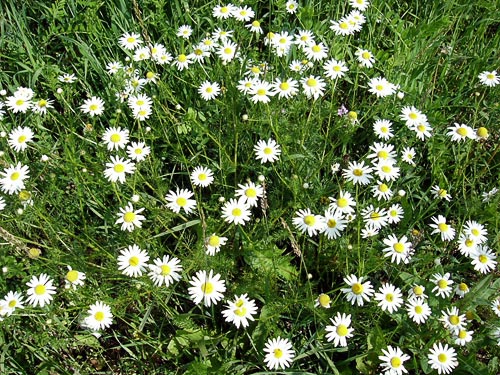Weeds
Tripleurospermum inodorum (L.) Sch. Bip. - Scentless Mayweed.
Systematic position.
Family Asteraceae, genus Tripleurospermum Sch. Bip.Synonyms.
Tripleurospermum perforatum (Merat) M. Lainz, Matricaria perforata Merat, M. inodora L., M. chamomilla L., Chrysanthemum inodorum L., Chamomilla inodora Gilib., Chamaemellum inodorum (L.) Vis. Fl. Daln., Pyrethrum inodorum Moench., P. parviflorum Willd., Rhytidospermum inodorum Sch. Bip.Biological group.
Annual weed that has spring and winter forms.Morphology and biology.
Root thin, fusiform. Stem straight or ascending, 30-75 cm in height, cylindrical, coreless inside, simple, branchy in upper half, glabrous, less often sparsely pubescent, striated. Leaves 3-8 cm in length, glabrous, sessile or short-petiolate, widened at base, two or three times pinnatisected, consisting of linear-filiform lobes, of which apical ones are 4-10 mm in length, having short point at apex. Pedicles long, with one anthodium, widened and sometimes slightly pubescent under anthodia. The latter are numerous or few in number, 1.5-4 cm in diameter. Involucral leaflets oblong, slightly widened at base, narrowly scarious along edges, white or light brown; external ones sometimes lanceolate, pale green, without scarious edges. Receptacle semi-globular-conic, glabrous, slightly scrobiculate. Marginal flowers ligulate, pistillate, white, spreading horizontally. Ligules 50-20 mm in length. Median flowers bisexual, golden yellow; their tube swollen in upper half; lobes often have bright red glands at apex. Hemicarp 2-2.5 mm in length, dark brown, flattened, wrinkled, with three white ribs along ventral side and with two large, red, rounded, oily glands on dorsal side. Pappus short, coriaceous, almost full. Blossoming occurs in June-September. Spreading occurs by seeds. One plant can produce 50,000-200,000, sometimes 1.5 million or more hemicarps. In ground, seeds of the Scentless Mayweed maintain their germination capacity for 6-7 years. Minimum temperature for hemicarp germination is +2-9°C; optimum temperature is +18-24°C. Seeds sprout early, simultaneously, at lower soil temperatures. Shoots appear from depths of no more than 1-2 cm in spring, as well as at the end of summer and in the beginning of autumn; summer and autumn seeds winter.Distribution.
Occurs throughout the European part of the former USSR, the Caucasus, Western and Eastern Siberia (adventive), the Far East (adventive), Western Europe, Atlantic Europe, the Balkans, Asia Minor, and North America.Ecology.
The plant is hygrophilous and undemanding to soil, growing both in damp clay soils and in sand. Grows along banks of rivers and ponds, along drains, along roads, in kitchen gardens, in fields, in gardens, in meadows, in saline soils, and on hillsides.Economic significance.
Infests tilled crops, especially thinned crops of clover and Lucerne, as well as grain crops, mainly winter ones. In the Non-Chernozem zone, it most strongly infests perennial grasses and winter grain crops. Hemicarps litter the ground and, less often, sowing material. Consumption of water by the Scentless Mayweed is 2 times more than that of oat and 1.5 times more than that of spring wheat. Economic threshold is 1-5 plants per square meter. Control measures include stubbling, autumn plowing, pre-seeding cultivation, cleaning of sowing material, inter-row treatments, crop rotation, and the application of herbicides, if necessary.Related references.
Chesalin, G.A. 1975. Weeds and their control. Moscow: Kolos. 256 p. (In Russian)Keller, B.A., ed. 1935. Weed plants of the USSR. V. 4. Moscow & Leningrad: AN SSSR. 416 p. (In Russian).
Komarov, V.L., ed. 1959. Flora of the USSR. Moscow & Leningrad: AN SSSR. V. 26. (In Russian)
Tanskii, V.I., Levitin, M.M., Ishkova, T.I. & Kondratenko, V.I. 1998. Phytosanitary diagnostics in integrated management of cereals. In: Novozhilov, K.V., ed. Compendium of methodical recommendations in plant protection. St. Petersburg: VIZR, p.5-55. (In Russian)
Ulyanova, T.N. 1998. Weeds in the flora of Russia and other CIS states. St. Petersburg: VIR. 344 p. (In Russian)


